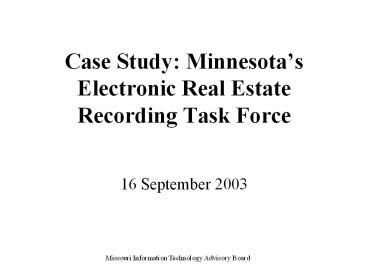Case Study: Minnesota - PowerPoint PPT Presentation
Title:
Case Study: Minnesota
Description:
Title: What is an electronic real estate recording system? Author: hortonrb Last modified by: Criag Kelso Created Date: 3/5/2002 5:39:36 PM Document presentation format – PowerPoint PPT presentation
Number of Views:91
Avg rating:3.0/5.0
Title: Case Study: Minnesota
1
Case Study Minnesotas Electronic Real Estate
Recording Task Force
- 16 September 2003
2
ERERTF history
- Formed in 1999 as a collaborative, volunteer
effort - Legislation and funding
- Lots and lots of planning
- Phase 1 testing underway
- Phase 2 testing slated for late 2003
- Completion and report to legislature in 2004
3
Stakeholders and TF members
- County Recorders, Auditors and Treasurers
- Legislators
- Fannie Mae and banks
- Title companies
- Lawyers and realtors
- GIS community
- State agencies (e.g. Department of
Transportation) - Minnesota Historical Society
- Notaries
- Faculty from Minnesota Law Schools.
4
What is recording?
- Recording is the act of entering deeds,
mortgages, easements, and other written
instruments that affect title to real property
into the public record. - The purpose of recording is to give notice, to
anyone who is interested, of the various
interests that parties hold in a particular tract
of land. Recording determines the legal priority
of instruments that affect title to a particular
tract of land.
5
What is in a real estate record?
- Buyer and seller
- Property description
- Legal rights
- Finances and mortgages
- Authorizations signatures
- Historical context past and future
- Aggregation of traditional forms
6
What is an ERER system?
- A publicly owned and managed county system,
defined by statewide standards, that does not
require paper or wet signatures, and under
which real estate documents may be
electronically - Created, executed, and authenticated
- Delivered to and recorded with, as well as
indexed, archived, and retrieved by, county
recorders and registrars of title and - Retrieved by anyone from both on- and off-site
locations.
7
Why is ERER important?
- Huge and increasing volume of filings
- Decreasing budgets for government
- Very slow and highly inefficient paper workflow
between automated activities - Secondary mortgage market demand for digital
records - Increasing complexity of property rights and
descriptions - Legislative mandate to develop common technical
and information architectures
8
What are the models?
- Level 1 images and minimal metadata
- Level 2 images, metadata, digital or digitized
signature - Level 3 so-called smart documents in XML
format, following recognized standards
9
Technology is not the problem
- Getting along
- Ordinary challenges to re-engineering
- Extraordinary political challenges to
re-engineering - Resources
- Setting standards
- Structuring unstructured documents
- Allocating costs and benefits
10
What are the standards?
- MN Electronic Real Estate Recording Task Force
- Mortgage Industry Standards Maintenance
Organization (MISMO) - Property Records Industry Association (PRIA)
- Legal XML
- GIS community
- Vendors (e.g., Ingeo)
11
What are the recordkeeping issues?
- Title insurance is vital insurance.
- Preservation formats, media
- Positioning Standards and architecture
- Information assets data re-use and enhancement
- Soft skills project management, education,
collaboration
12
Where to learn more
- MN ERERTF http//www.commissions.leg.state.mn.us/l
cc/erertf.htm - MISMO http//www.mismo.org
- PRIA http//taskforce.cifnet.com/priaus/
- Legal XML http//www.legalxml.org/
- MN Technical Architecture http//www.ot.state.mn.u
s/architecture































